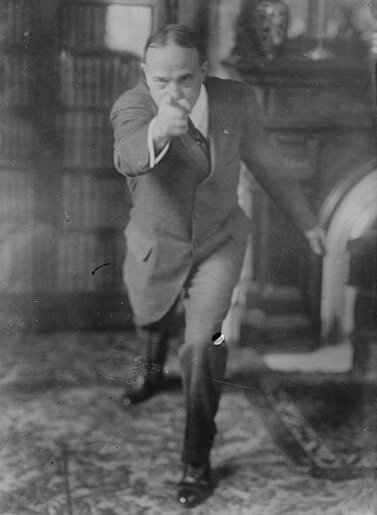Sex, Science, and the End of the World
In the 1920s, a new cultural icon emerged in white, middle-class America: the flapper. This bobbed-hair woman raised her hemline, went to dance halls, smoked, and enjoyed sex with new methods of contraception. She bore little resemblance to the stereotypical Victorian woman of the 19th century, who dwelled at home to protect her frail constitution and blushed at the mention of sex. The flapper greatly enraged certain moral authorities, who interpreted her habits as a sign of modern-day depravity and imminent apocalypse. Authorities like evangelist Billy Sunday warned that if women didn’t fulfill their duty as guardians of virtue, society would collapse.
But the flapper wasn’t the only one to incite doomsday fears. The deceased Charles Darwin, whose evolutionary theory was gaining popularity, also stirred contempt. For figures like Sunday, female sexuality and evolution were fundamentally the same—both were shorthand for sin-laden, racially diverse “modernity,” which was going to result in global destruction. Both affirmed women’s natural (biological) instincts and undermined the authority of the Bible to enforce gender norms. By intertwining sex and science, “fundamentalist” Protestants hoped to resist the growing influence of “worldliness” in their churches and society.
“Female sexuality and evolution were fundamentally the same—both were shorthand for sin-laden, racially diverse ‘modernity,’ which was going to result in global destruction.”
Fundamentalist fears about the end of the world, fueled by changing sex and gender norms and evolutionary science, would ultimately reach beyond the era of the flapper and find new iterations of modernist worldliness to combat. The history of this modernist-fundamentalist divide helps explain how and why sex and science became such critical political fault-lines, now demonstrated by the centrality of cultural and political debates about birth control, LGBTQ+ rights, and the teaching of sex education.
The 1920s were a time of great change for American Protestantism, as doctrinal liberalism swept churches. Emboldened by feminism and Darwinian theory, among other social and intellectual trends, many believers found traditional church teaching outdated. These “modernist” Protestants began to advocate for divorce and birth control, arguing in the case of birth control that sex was inherently sacred, regardless of its procreative potential. They also began to question such concepts as the divinity and Virgin birth of Christ. Practicing a form of “higher criticism,” they suggested that such details of the Gospel might be more allegorical than literal. In any case, modernists claimed Christ’s persona mattered far more than the historicity of certain details, and by imitating his ethics of grace and love, they could usher in a heaven on earth.
Whereas fundamentalists like Sunday believed the world was careening toward apocalypse and their only hope was to save souls before Judgment Day, white modernists were optimistic about the reform-driven times. As far as they were concerned, Darwin’s account of the species signaled a true advancement of life on earth. Most African American liberal Protestants did not share this sense of hope, however, as they endured intense discrimination and violence. Nor did they, as a whole, support reforms like birth control. But they generally agreed that it was Christians’ duty to improve human society on earth—and that Darwin’s theory, pointing toward a common ancestor, suggested the equality of human beings.
Many fundamentalists likewise linked evolution to racial plurality, opposing the former in racial terms. “I say there is ten times more respect for God and the Bible...in the South than in any other part of the United states,” Sunday once observed. “[T]here is more Anglo-Saxon blood in the people, and they have not felt the infiltration of this great horde with their Continental ideas…” By idealizing the Christian virtue of the South—the heart of chattel slavery—during a time of massive Eastern European immigration to Northern cities, Sunday betrayed that racial anxieties, in addition to gender-related anxieties, underlie concerns about the waning authority of the Bible, which had long been used to justify the oppression of African Americans
Outraged over the “barnyard morality”, or lawlessness, fundamentalists perceived to be taking hold, they doubled down on gender norms and traditionalist readings of scripture. They often did so by feminizing their scientifically-minded opponents. A contributor to Searchlight magazine lambasted liberal professors as “sissy.” The editors of the conservative magazine King’s Business called modern theology “emasculated Christianity.”
A former baseball player, Sunday became known for his displays of strength toward his revivals, shouting and throwing punches at his critics in front of cheering crowds. He claimed strong men were needed to resist the degradation of Christianity and the white American race. “Lord save us from the off-handed, flabby-cheeked, brittle-boned, weak-kneed, thin-skinned, pliable, plastic, spineless, effeminate, sissified, three-caret Christianity,” he once sermonized.
Young Men’s Christian Associations (YMCAs) flourished, as Christians like Sunday sought to combine traditional values with physical virility. Church leaders also tried to attract more men to the faith by taking young ones on fishing, hunting, and swimming trips. They buffed up Jesus, too. Realizing the bleeding savior long depicted in religious art wasn’t going to serve their crusade, fundamentalists reimagined the Lord. “Today we think of [Christ] as strong,” a contributor to the Record of Christian Work wrote . “It is not the ascetic but the athletic in Jesus that grips the heart today.”
As the century wore on, the feud between modernists and fundamentalists morphed into the “culture wars” of the 1970s. Sunday’s conservative evangelical heirs found allies in the Republican party, who were willing to fight against abortion, gay rights, and sex education, prompting liberal believers of many faiths and secular progressives to resist what they perceived to be a blatant consolidation of Church and State. From the perspective of conservative evangelicals, abortion, gay rights, and sex education extended the legacy of flappers and Darwinism. By seeming to sanction non-procreative, extra-marital sexuality, these practices gravely undermined the conservative gender norms from which straight white Christian men benefited.
“From the perspective of conservative evangelicals, abortion, gay rights, and sex education extended the legacy of flappers and Darwinism.”
The divisions between conservative and liberal believers have only intensified over time, as high-profile conservatives continue to invoke doomsday notions—and a masculine, authoritative God—to enforce certain sexual and doctrinal norms. A few days after 9/11, the evangelical Reverend Jerry Falwell, Sr. blamed the terrorist attack on “feminists,” “gays,” “lesbians,” and others whose lack of faith prompted God’s wrath. The Reverend James Dobson later blamed the Sandy Hook shooting on the same people. Besides inciting contempt for people who had nothing to do with the tragedies, both men falsely implied that women’s liberation and LGBTQ+ existence are fundamentally opposed to belief in God.
For many influential conservatives, atheism (often equated with science) and non-procreative, extramarital sexuality are two sides of the same coin—both constitute threats to the social order that only Christian manliness can surmount. This may explain why so many evangelicals appeal to militarist metaphors, like “Warriors for Christ,” to describe their ministry—and why some regard the hyper-masculine, anti-intellectual in the White House as the “Chosen One.”
But many liberal believers, who receive far less media attention and who have far less political influence, champion skepticism and progressive reforms in the name of achieving peace and equality on earth. Like the modernists before them, they envision a world in which science and diverse faiths work in tandem, and in which humanitarianism triumphs over the Law.
Further Reading
Betty A. DeBern, Ungodly Women: Gender and the First Wave of American Fundamentalism (Mercer UP, 2000).
Marie R. Griffith, Moral Combat: How Sex Divided American Christians and Fractured American Politics (Basic Books 2017).
Image credit: Model with Flapper pillow and Pointy Shoes, 1920 (Wikimedia Commons | Public Domain)







